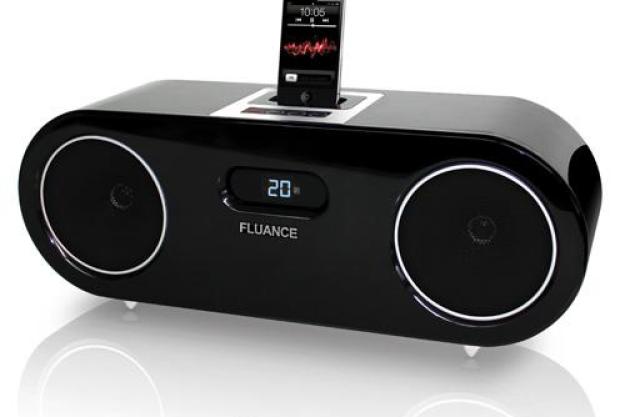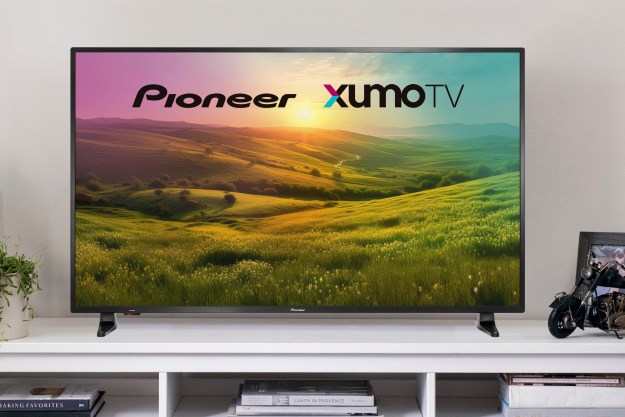
“We admit to being a little tough on the $220 Fluance FiSDK500, but we only did so because this speaker has so much potential. As it stands, this piece does sound bigger and more accurate than most (if not all) others in its class.”
- Real wood cabinetry
- Attractive gloss-black finish
- Composite and S-Video output
- Excellent treble response
- Lacks low frequency extension
- Some midrange coloration
- Short on features
- Not portable
We remain amazed at the glut of available iPod speaker docks today. Consumers have made it clear that they aren’t interested in simply patching their iPod into their existing audio equipment (a proposition that is usually just a $7 cable away). No, a dedicated iPod speaker system is where it’s at and we now have plenty to choose from.
Perhaps as a result of high demand and hurried development, this rapidly expanding product category has been stumbling its way through a bit of an identity crisis. On the low end of the spectrum we have what are essentially the iPod-friendly versions of clock radios or other similarly compact speakers, many of which only squeak out sound just slightly better than the iPhone’s built in speaker. On the high end of the spectrum are the healthily-priced, sonic overachievers often equipped with Airplay and/or Bluetooth wireless capability, DSP, multi-channel amps, remote controls, customizable EQ, dedicated apps and all sorts of other frills. As such, we now have a truck-load of average-sounding sub-$100 speaker dock options flanked by plenty of excellent-sounding $500 and up choices, too.

Whether done intentionally or not, that’s the crowd that the Fluance FiSDK500 iPod/iPhone speaker dock has the potential to serve. It may not offer wireless music streaming or FM radio and you certainly won’t be hauling it out to the garden or beach, but it offers what very few others do: real wood cabinetry and full-size speaker drivers; attributes which, in theory, could help contribute to some excellent sound.
The question is: does the FiSDK500 actually sound good enough to justify missing such popular and widespread features? We spent a good amount of time with the FiSDK500 and feel we have the answer, but before we issue our opinion, let’s first dig into some of the FiSDK500’s specs and details.
Out of the box
The FiSDK500 arrived double-boxed with a reasonable amount of EPS (the messy kind) foam padding. This is important because the FiSDK500 is only shipped directly to consumers by either Fluance itself or Amazon and needs to survive the trip. What’s more, solid packaging is critical because the speaker’s finish –one of its finer attributes– is prone to dings and no one wants to receive a dimpled iPod speaker.

The finish is prone to damage because, unlike most speaker docks, the FiSDK500’s cabinet is made of wood; internally braced MDF, to be precise. The cabinet is then finished in the ever-popular glossy piano-black look. Though perhaps not executed quite as well as some competing speaker manufacturers, the finish still looks attractive.
The wood cabinetry and built-in power supply combine to help bring the FiSDK500’s weight to 13.4 lbs. Add that figure to its 20.4 × 5.8 × 7.1-inch dimensions and you have one of the bulkier, heavier speaker docks on the market.
Packed with the speaker were a compact remote control, six dock inserts, some composite A/V cables and an instruction manual. Since the power supply for this speaker dock is built into the cabinet, the cord is hardwired to the dock. Yay! No power-bricks to contend with!
Features and Design
The FiSDK500’s speaker component includes two 0.6-inch silk dome tweeters mounted in the center of two 5-inch woven fiberglass composite woofers, thus making it the second largest set of mid/bass drivers in a speaker dock that we’ve tested, save the Kanto SYD 5. To reinforce bass response, two flared ports have been placed on the rear of the cabinet.
Amplifier power for the FiSDK500 is rated at 2 x 10 watts and Fluance claims the amp can deliver these 20 watts continuously. The rated frequency response for this speaker is 40Hz-20kHz/+- 2db, which seems like a pretty bold claim. Most 5-inch bookshelf speakers don’t reach nearly that low into the bass region.
The back panel of the speaker dock offers stereo RCA inputs as well as composite video and S-video output. The bottom of the cabinet sports threaded inserts for provided metal spikes and disks. This is usually a feature found on floor-standing speakers and their effect, positive or negative, is debatable. We recommend sticking with the provided rubber feet.

The top of the cabinet is where we find the recessed iPod/iPhone docking area. In front of the docking port are buttons for power, input selection and volume up/down.
The front of the speaker has an unusually large glass display window which covers a very basic two-character LCD display. Directly below the display is the Fluance name badge.
As we stood back and considered the FiSDK500’s appearance, we couldn’t help but find it a little…well, generic. We enjoy simplicity as much as anyone but this speaker dock’s appearance is a little too basic for our taste. Between the low-tech LCD, un-inspired badge font, low-tech control buttons and plastic silver grill trim, we get the feeling that much of this speaker’s design was pulled off the shelf of a Chinese factory, even though we suspect that is not actually the case. A few graceful cosmetic touches would go a long way to classing up this speaker, but, at $220, does it really matter?
Performance
Evaluating the FiSDK500’s sonic performance was an arduous task. Here we have a speaker dock that looks more like two well-designed bookshelf speakers and a built-in amp all wrapped up into a tidy package than it does a modern-day plastic-y boom box. That being the case, we found ourselves expecting a refined sound and tended to want to judge it against the performance of quality bookshelf speakers.
Yet, given that the FiSDK500 rings in at $220, it seemed more appropriate to judge it against its like-priced competition. The Altec Lansing iMW725, Soundfreaq SFQ-01, Harman/Kardon Go+Play Micro and iHome iP4 all fall into the same price category but offer far more bells and whistles.
After banging our heads against the wall for a while, we ultimately decided that if the FiSDK500 was going to skip out on the features of its like-priced cohorts, then it ought to produce sound quality on par with more expensive docks like the Klipsch G-17 Air or B&O Beolit 12.
We gave the FiSDK500 about 20 hours of break-in, which proved very beneficial. Almost every aspect of the speaker’s performance showed obvious improvement over its out-of-box performance. Should you decide to pick one of these up, we strongly recommend you plan to do the same before making a final call on whether this speaker is right for you.

Bass performance was one area where we simply expected better of the FiSDK500. Between the 5-inch drivers, excellent cabinetry and flared ports, we expected the speaker would play a bit lower. To be fair, the bass that this dock does produce is in balance with the rest of its output, but it rolls off too early for our liking. On tracks like Marcus Miller’s “Mr. Pastorius”, Miller’s tone would simply disappear as he would glissando (slide) toward the lower end of his electric bass. Fortunately, the speaker does offer a decent amount of punch, which does help to fill out the low end and present a fairly full sound.
Midrange performance was good, but we did find some coloration came into play when we carefully listened to vocals. The distinct timbre from the voices of Adele, Sheryl Crow and Norah Jones sounded just a little bit off. At their lowest, they sounded a bit rich and at their highest, stripped of their body. Again, we are intentionally nitpicking here.

The FiSDK500 did far better with Jazz –be it big band or small group– than it did with, say, R&B or Hip Hop. The extended low frequency demands of the latter styles were a little more than the FiSDK500 could deliver. Yet, with some of our jazz favorites, the material’s limited bass requirements combined with the speaker’s relatively unclouded midrange and tasty treble made for a truly enjoyable listening experience.
Conclusion
We admit to being a little tough on the $220 Fluance FiSDK500, but we only did so because this speaker has so much potential. As it stands, this piece does sound bigger and more accurate than most (if not all) others in its class. However, considering it’s missing a lot of popular features, we feel it needed to sound a few notches better than it did.
Is the FiSDK500 a value for its asking price? We think that depends on the needs of the listener. For our part, we’d be willing to spend a few more dollars for just a bit more bass and a slightly flatter frequency response in the midrange section. Otherwise, this is a totally respectable product and well worth looking into for those without space concerns or need for fancy features.



